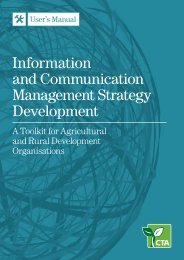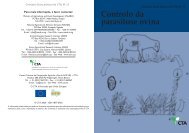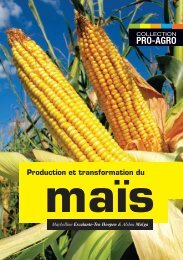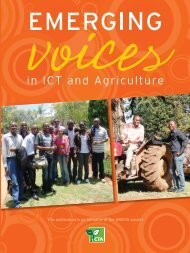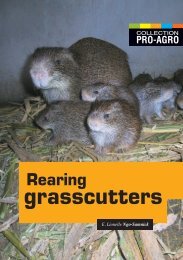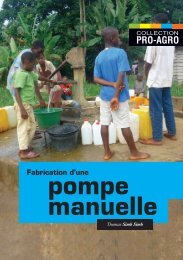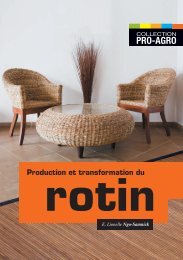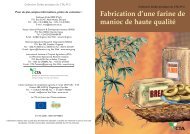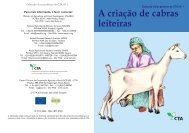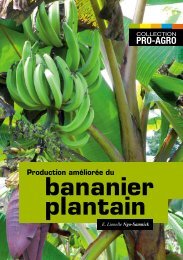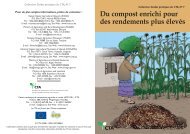Policy framework for Pastoralism in Africa
Policy framework for Pastoralism in Africa
Policy framework for Pastoralism in Africa
- No tags were found...
You also want an ePaper? Increase the reach of your titles
YUMPU automatically turns print PDFs into web optimized ePapers that Google loves.
c) Semi-arid rangelandsThe semi-arid rangelands are found <strong>in</strong> the grassland, the savannah, and the thicket biomes andcomprise all the rema<strong>in</strong><strong>in</strong>g land which is not suitable <strong>for</strong> commercial ra<strong>in</strong>fed agriculture. Ra<strong>in</strong>fallvaries from 250 mm to 800 mm per year. Semi-arid rangelands exist <strong>in</strong> South <strong>Africa</strong>, Namibia,Botswana and Zimbabwe.d) Karoo or semi-desert plateauThe Karoo or semi desert plateau is found <strong>in</strong> the western part of South <strong>Africa</strong>. It is divided <strong>in</strong>totwo ma<strong>in</strong> physical sett<strong>in</strong>gs from the north-west to the south-west, notably: the Nama Karoo <strong>in</strong> theNorth and the small or succulent Karoo <strong>in</strong> the south.The Nama-karoo characterises the central and western regions of South <strong>Africa</strong> and southernNamibia. The biome is dom<strong>in</strong>ated by steppe-type vegetation, compris<strong>in</strong>g a mixture of shrubs, dwarfshrubs, and annual and perennial grasses. The biome is associated with the moderate ra<strong>in</strong>fall regions(250 to 450mm per annum) and is ideal <strong>for</strong> sheep and goat production.The succulent karoo occupies the w<strong>in</strong>ter ra<strong>in</strong>fall regions of the southern and south-western portionsof South <strong>Africa</strong>. The flora of the biome comprises ma<strong>in</strong>ly shrubs and dwarf shrubs withsucculent leaves and stems. The climate of the region is arid to semi-arid (100 to 350mm ra<strong>in</strong>fallper annum), with a strong w<strong>in</strong>ter seasonality.e) Thicket rangelandThe thicket rangeland is found <strong>in</strong> South <strong>Africa</strong> <strong>in</strong> the dra<strong>in</strong>age l<strong>in</strong>es and ridges of the south easterncoastal region and <strong>in</strong>land to the Great Escarpment. Ra<strong>in</strong>fall ranges from 300 mm to 450 mm peryear. The flora of the biome comprises ma<strong>in</strong>ly shrubs and dwarf shrubs and the climate of theregion is arid to semiarid (100 to 350mm ra<strong>in</strong>fall per annum), with a strong w<strong>in</strong>ter seasonality.2.3 Economic contextThe contribution of pastoralism to national economies is most commonly expressed <strong>in</strong> terms ofproportion of Gross Domestic Product (GDP), which <strong>in</strong> turn, is calculated from national livestockpopulations and production coefficients. There<strong>for</strong>e, GDP <strong>in</strong>dicators are <strong>in</strong>direct measures and <strong>in</strong>part, depend on estimates of the proportion of the national herd found <strong>in</strong> pastoral areas of thecountry concerned. In general, pastoralism contributes 10 to 44 percent of the GDP of <strong>Africa</strong>ncountries. The pastoralist population <strong>in</strong> <strong>Africa</strong> is estimated at 268 million (over a quarter of thetotal population), liv<strong>in</strong>g on area represent<strong>in</strong>g about 43 percent of the cont<strong>in</strong>ent’s total land mass.Official statistics tend to overlook many important economic benefits of pastoral livestock. Thesebenefits <strong>in</strong>clude household consumption of livestock products, especially, milk, which is a particularlyvaluable food <strong>for</strong> children, and pregnant or nurs<strong>in</strong>g mothers. Livestock are also used <strong>for</strong> transportand plough<strong>in</strong>g, and work animals can be hired out to traders or farmers. Manure improves soilfertility and can be dried and used as fuel. Livestock sk<strong>in</strong>s have a variety of domestic uses. Livestockare also the basis <strong>for</strong> traditional social support systems <strong>in</strong> many pastoral communities, provid<strong>in</strong>g a<strong>for</strong>m of traditional <strong>in</strong>surance system <strong>in</strong> the face of shocks. Nearly all important social events <strong>in</strong>16 <strong>Policy</strong> <strong>framework</strong> <strong>for</strong> <strong>Pastoralism</strong> <strong>in</strong> <strong>Africa</strong>




